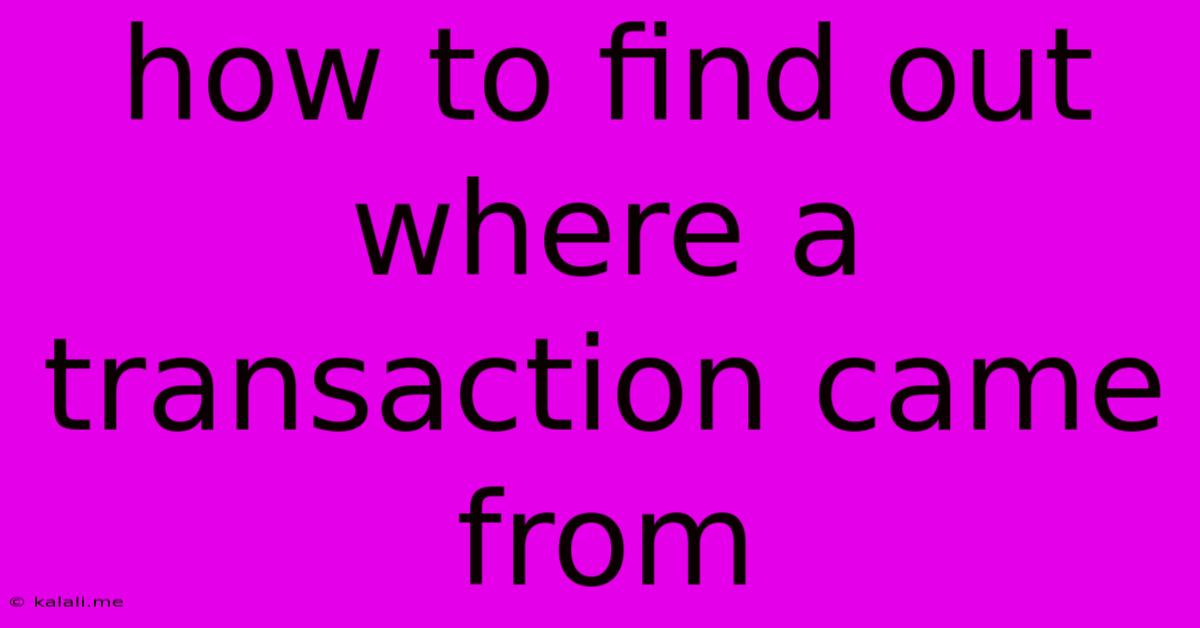How To Find Out Where A Transaction Came From
Kalali
Jun 07, 2025 · 3 min read

Table of Contents
How to Find Out Where a Transaction Came From: A Comprehensive Guide
Meta Description: Tracing the origin of a transaction can be crucial for various reasons, from security investigations to accounting reconciliation. This guide provides comprehensive strategies for identifying the source of different types of transactions, including online payments, bank transfers, and more.
Tracking down the origin of a financial transaction can be critical for a variety of reasons. Whether you're investigating a fraudulent charge, reconciling your accounts, or simply need to understand your cash flow, knowing where a transaction came from is essential. This guide outlines various methods for identifying the source of different transaction types.
Understanding the Type of Transaction
The first step is to identify the type of transaction you're investigating. This will significantly influence the methods you use to trace its origin. Common transaction types include:
- Online Payments: These include payments made through platforms like PayPal, Stripe, Venmo, or directly through a website.
- Bank Transfers: These involve moving funds between bank accounts, either domestically or internationally.
- Credit/Debit Card Transactions: These are purchases made using physical or digital cards.
- Cash Transactions: These are transactions conducted using physical currency.
- Cryptocurrency Transactions: These involve the transfer of digital currencies like Bitcoin or Ethereum.
Tracing the Origin of Different Transaction Types
The process of tracing the origin varies depending on the transaction type. Let's explore each type individually:
1. Online Payments
- Check the Payment Platform: Most online payment platforms provide detailed transaction history, including the sender's email address, name associated with the account, and sometimes even their location (though this is often limited for privacy reasons).
- Review Your Email and Account Statements: Look for confirmation emails from the payment platform or the merchant. These emails often contain transaction details and the sender's information.
- Contact the Payment Provider: If you need further assistance, contacting the payment provider's customer support might provide additional information.
2. Bank Transfers
- Review Your Bank Statements: Bank statements usually include the sender's account number (though not always the full name or other identifying information for privacy reasons).
- Contact Your Bank: Your bank's customer service can potentially provide more information about the sender, particularly if you suspect fraudulent activity. They may require additional documentation to protect your privacy.
- Consider Wire Transfer Information (if applicable): Wire transfers often include a sender's reference number or other identifying details.
3. Credit/Debit Card Transactions
- Check Your Card Statement: Your credit or debit card statement will show the merchant's name, location (often city and state), and transaction date.
- Contact Your Card Issuer: If you suspect fraudulent activity or need additional details, contacting your card issuer (the bank or credit union that issued the card) is crucial.
- Review Merchant Website: Often the merchant's website will have a record of your transaction.
4. Cash Transactions
Tracing the origin of cash transactions is significantly more difficult. Unless you have a record (such as a receipt from a business), it's generally very hard to determine the precise source of cash.
5. Cryptocurrency Transactions
Tracing cryptocurrency transactions involves understanding blockchain technology. While transactions are public on the blockchain, identifying the actual person or entity behind an address often requires specialized tools and expertise. There are blockchain explorers that can provide some information, but linking addresses to individuals is typically challenging.
Protecting Yourself from Suspicious Transactions
Regardless of the transaction type, taking proactive measures can help protect you from suspicious activity:
- Regularly monitor your accounts.
- Enable transaction alerts.
- Use strong passwords and multi-factor authentication.
- Report any suspicious activity immediately.
Finding the source of a transaction requires careful investigation and depends heavily on the nature of the transaction itself. By following the strategies outlined above and taking appropriate precautions, you can improve your chances of successfully tracing the origin of your transactions. Remember to always prioritize your financial security and report any suspected fraudulent activity.
Latest Posts
Latest Posts
-
I See Said The Blind Man Full Poem
Jun 07, 2025
-
What Is Called When A Trap Goes Off Anf
Jun 07, 2025
-
Android Phone Different Colors For Different Colors
Jun 07, 2025
-
How To Do A Barrel Roll
Jun 07, 2025
-
What Happens To Falcon Heavy Center Booster
Jun 07, 2025
Related Post
Thank you for visiting our website which covers about How To Find Out Where A Transaction Came From . We hope the information provided has been useful to you. Feel free to contact us if you have any questions or need further assistance. See you next time and don't miss to bookmark.